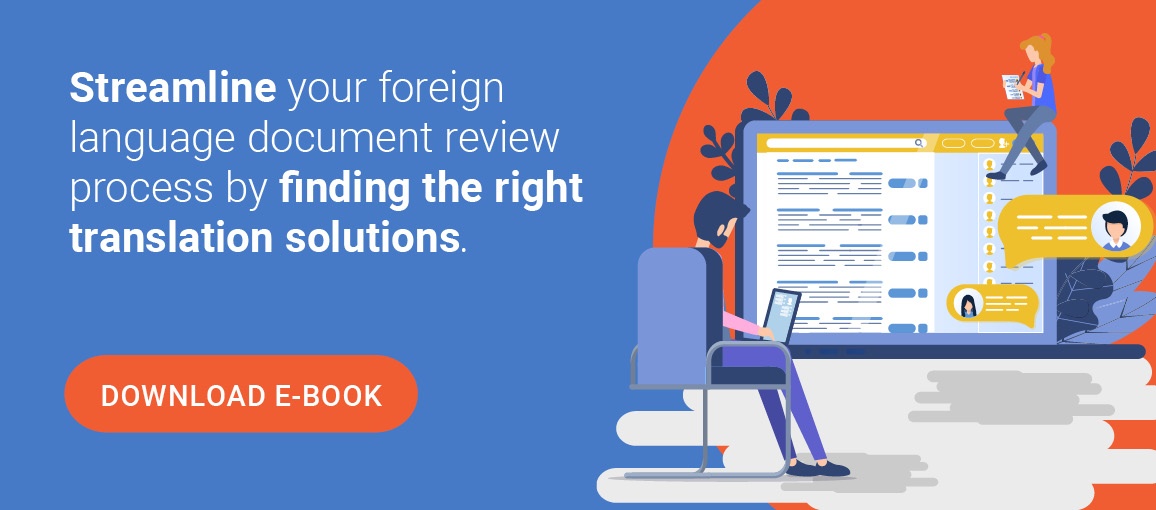Sorting through documents in a legal case is a task in itself. Finding relevant materials for trial can mean sifting through thousands of pages of records in order to find documents that are pertinent to a specific legal dispute.
And, when you throw in multilingual content, things get even messier. That is, unless, you’ve developed a streamlined e-discovery process to make things easier on yourself.
E-discovery is the process in which any Electronically Stored Information (ESI) is collected as part of a legal case. This entails searching through emails, hard drives, servers, websites, social media and audio recordings in order to dig up information that could be useful in litigation.
In the digital age, the practice has become ubiquitous in multilingual investigations, and new technologies like Language Identification (LI) and keyword searches help law firms expedite the process. However, since it’s a relatively new endeavor, there are still some questions about best practices.
A Number of Moving Parts
E-discovery has been around longer than most people realize. The first email was sent almost 50 years ago in 1971, and searching for data electronically has been going on ever since. According to Kroll Ontrack, there were less than 10 e-discovery cases in the 1970s, compared to more than 360 from 2010-2015.
And the number of cases that use e-discovery is no doubt going to get larger as technology continues to advance. These days, successful businesses work on a global scale, and with more international commerce comes more multilingual litigation.
Piecing together a successful multilingual investigation involves a number of different moving parts (including a successful project team, Machine Translation (MT), and skilled linguists) and is a key component of the litigation process.
But the question of how to reconcile the accuracy of human translators and the efficiency of MT can stump some law firms and Language Service Providers (LSPs) alike. However, there are ways to break through the human/machine dichotomy by employing a human touch while still maintaining some reliance on 21st century technologies.
In order to get the most out of e-discovery, consider the following.
MT is Cheap But It’s Not Perfect
One of the biggest benefits of digging through ESI is the ability to review materials quickly. LI allows firms to see what languages documents are published in while keyword searches make it easy to find certain words or phrases that are relevant to a case.
Once the LI phase is completed, firms will have the opportunity to have documents translated via machine or by a linguist. Right off the bat, MT is cheaper and quicker – and saving time and money is at the forefront of any attorney’s mind.
But, MT can botch certain translations that contain nuance or metaphor. And if something isn’t translated right, it can hurt an investigation. Consider having a linguist skilled in the legal industry review documents that require extra attention.
Generally speaking, MT should be used for documents that need a “gist” translation and don’t contain text that will be difficult for a computer to decipher.
Strong Project Management Goes A Long Way
Humans aren’t only needed to translate documents; they’re also an integral part of directing translators throughout the e-discovery process. A project manager who speaks the target language is a necessary component, able to speak with translators directly.
For this reason, hiring a strong LSP is essential. Not only will a project management team manage linguists, but it will also streamline the workflow process. LSPs should also have a capable Translation Management System (TMS) in order to facilitate the delivery and submission of documents that need to be translated.
Skilled Linguists Still Matter
E-discovery is a process that relies heavily on digital tools for speed and accessibility. But, like most processes in translation today, employing skilled linguists is still a necessary piece of the puzzle.
Translators with experience in the legal field will be able to accurately translate documents and speak legalese, a requirement for legal language solutions. Of course, using machine automation to locate and identify relevant documents is a tremendous help for firms, but after these items are deemed important to a case they should be reviewed by professionals.
And this doesn’t mean that MT should be thrown out the window altogether. Using a combination of MT and post editing can produce top notch results and get the job done on tight deadlines. Whatever the case, it’s important to make sure your translations are correct, and MT isn’t a fail-safe method when it comes to accuracy.
The Right People and the Right Technologies
At the end of the day, quality e-discovery processes call for strong translators, MT strategies and project management. There will be different variables for different projects – some need faster turnarounds, some will present budget constraints – but ultimately, working with the right people and technology will help streamline the process.


